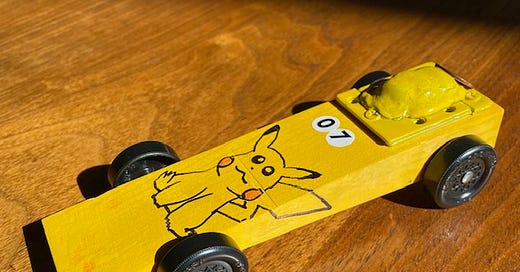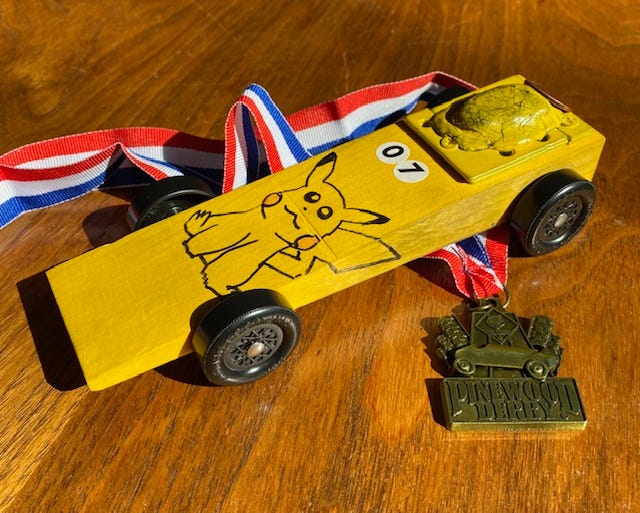Confessions of a Pinewood Derby Dad
It's about doing a project together. But if you ain't first, you're last.
I was researching tungsten putty when I realized I might be headed down a dark path.
But let’s step back a moment.
My son recently joined Cub Scouts. It’s been a nice experience for both he and I so far, even if the majority of our den meetings devolve into a pile of seven boys wrestling on the floor of someone’s basement rec room. We’ve both made new friends, had some good talks about Scout values such as trustworthiness, courtesy and bravery, and even started to think about some camping trips once the weather gets warmer.
There’s one thing I was especially looking forward to, though. You see, I was a Cub Scout myself some thirty years ago, and though I don’t remember much of the oaths or rituals, I did remember the Pinewood Derby.
For the uninitiated, the Pinewood Derby is a Scout tradition stretching back nearly seventy years. Scouts are given a 7” x 1-3/4” block of wood, four nails, and four plastic wheels, and are charged with turning it into a car, one they’ll race down an inclined metal track. Beyond a few key parameters—maximum width, length, and weight—the only limitations are the Scout’s ingenuity and creativity. It’s an event I participated in with my Dad when I was a kid, and though I don’t recall exactly how my car did1, I fondly remember sitting with him at his workbench as we shaped and crafted our car, and I was excited to revisit the tradition with my son.
As soon as we were issued our car blanks, I sat my son down at the kitchen table, sketchpad in hand, and inquired about what he wanted to do for a car design.
“Pokémon.”
This is his answer to pretty much any question these days. What’s your favorite show? What do you want to wear today? What do you want to be when you grow up? Is there anyone you love more than your mom and dad?
“Pokémon.”
In this instance, at least, it’s a request that could be accommodated.
“Okay, great. Pikachu is mostly yellow with some black and red—we can spray-paint the car yellow, then do the detail work with markers. Any thoughts on the actual car shape?”
He shrugged.
“Let’s see what the internet has to say.”
I tapped out a search, and we quickly landed on a YouTube video wherein a twentysomething man—earnest in that mildly-unnerving way that only the most successful YouTubers can be—explained the basics of Pinewood Derby car design. You want to minimize the profile of the car, he explained, while shifting the center of gravity to a point around 3/4” in front of the rear axle of the car. The best way to do this is to cut the block into a simple wedge shape, and then add weight onto the back as needed.
Seemed simple enough. I sketched out a design on my notepad, and my son nodded.
Next, it’s important to reduce friction on the wheels. This can be done with powdered graphite lube, but also by polishing the nails that would serve as the car’s axles—this could add important percentage points to the car’s speed.
I was taking extensive notes by now; my son’s eyes were glazing over.
A few more fractions of a second could be shaved off by canting the tires, so that the car would only be riding on the very edge of each wheel. The best way to do this, the YouTuber demonstrated, was to bend each of the nails exactly 2.5 degrees. Also, one of the nails should be raised even further, because studies have shown that the cars ride faster on three wheels than they do on four, and—
I paused the video to catch my breath.
My son was playing with the wheels, his interest in the introductory physics lesson the presenter was attempting to give long since gone. I thought about what was in my grasp; I could borrow a friend’s bandsaw to cut the block into a wedge shape, then use a power drill and a strip of sandpaper to polish the nails. From there, I’d just need a few weights to get the center of gravity right, and I could say we made a good, honest effort.
I pulled up Amazon, and bought a small tube of graphite lube. A few minutes later, I placed a second order, having located a tungsten putty that could be cut, molded and shaped exactly as needed. As soon as I placed that order, I was fed a recommendation for a special jig that would help me insert the nail-axles as straight as possible.
That’s a good idea, I thought. I should order that, too. It’s only five bucks.
There’s a tipping point, it would seem, in between one’s second and third orders for aftermarket Pinewood Derby car accessories—a point when the algorithm senses that you may be possessed of a sickness of the mind and opens the floodgates. Suddenly, my recommended products—once a mixture of kitchen supplies, books, and children’s toys—were all for Pinewood accessories. Professional-grade parts. Pre-polished nails pre-bent to exactly two and a half degrees. Decal sets. Test tracks. Whole pre-made cars—for just $69.99 or four installments of $17.50, you could have your very own top dragster, without any of the work!
I resisted falling down that rabbit hole, but then I made a mistake.
I looked up “what is a good Pinewood Derby car time?”
And that’s when I ended up in the message boards.
It is a fact of life in the digital age we live in that any thing a person can enjoy doing as a hobby—whether that be collecting Pokémon cards, cast-iron cookery, college football fandom or, indeed, racing tiny wood cars down a metal track—can also be turned into a toxic subculture of deranged obsessives.
This same question had been posed on a forum about five years ago, and the responses were frighteningly detailed. Well, it depends on a lot of variables. Is it a Freedom Track or a BestMade Track? 42 feet or 45 feet? Was the track properly calibrated when it was set up? It’s hard to answer without more information.
I was experiencing the miniature car-racing equivalent of making an offhand remark to a coworker about traffic being bad today and receiving a lecture about how red lights are a New World Order conspiracy.
I closed my laptop, and took a deep breath.
This is a race for grade-school kids, I reminded myself. This isn’t supposed to be a competition between Dads. The point is just to have fun, and do something together with my son.
I set aside the most-aggressive and expensive modifications, and set to drawing up a plan with him, taking pains to not hijack his intentions myself.
We settled on a simple design. I cut the car into a wedge, and we polished the nails. We weighted and balanced the car as instructed, adding a few stray pieces of hardware I had on my workbench to get us just below the weight limit. We spray-painted the block bright yellow, and I drew a Pikachu on the top, copying as best I could from an image I’d Googled. I carefully inserted the nails using the jig, all the while worrying that I’d put them in a half-degree off plumb and torpedo our entire effort.
My son was tickled with the end result, and when we arrived a week later at the church basement that would serve as our Talladega for the day, his friends oohed and aahed at his Pokémon car. As we checked in, I reminded him—and myself—that we were going to be proud of the car we’d made together no matter what happened.
Privately, I just hoped that it didn’t finish last or jump off the track entirely.
Each car would run in four heats—one on each lane of the four-lane track, a method intended to correct for any inconsistencies between lanes. The slowest of the four times would be dropped, and the other three would be averaged to give him his time.
First heat: win. I pumped my fist in the air.
Second heat: another win.
Third heat: second place.
Hey, is this a BestMade track or a Freedom? Who calibrated it?
Fourth heat: win.
While we worked through several dozen more heats, the pack leader reminded the collected crowd of kids and parents that the top three kids across all age groups would get to go to regionals, and I suddenly recalibrated my ambitions to “I hope he finishes fourth”.
When they announced the results, he’d won his age group—three hundredths of a second faster than his closest friend in the pack. He jumped up and down, screaming in celebration while his friends cheered on Pikachu’s victory. In the end, he finished sixth overall—a highly-respectable finish for a first-time competitor.
As we got home, he looked at his age-group medal, and mused that he wished he’d gotten one of the trophies that went to the overall finalists.
“Now, buddy, that’s no way to look at this. We had fun building that car together, and you did awesome. Also, your friends were so supportive. I think it’s really awesome that you got a medal—on your very first try!—and I’m really glad we got a chance to do this together.”
He nodded, humoring me the way he does when I’m trying to be a Sitcom Dad.
“Yeah. I had fun. But next year I want to do even better!”
I was already opening my laptop.
“I have some ideas.”
—Scott Hines (@actioncookbook)
I assume I did not win. I think I’d remember that.





"Building a home wind tunnel for your pinewood derby car" - the greatest thread in the history of forums, locked by a moderator after 12,239 pages of heated debate,
Wow. That one brings back some memories. My hometown Cub Scout pack consisted about 50% of kids whose dads worked at the Ford plant -- and had lunchtime access to the machine shop and paint room. You ever seen a Pinewood Derby car with clear coat? Yup.
The Old Bobcat was the polar opposite of that. (My eighth-grade educated grandfather explained to his peers that "we had to send him to college because he'd never make a livin' with his hands.") So, Devil Bro and I hacked a car out of the wooden block with a coping saw, spray painted it hot pink, and put a tiny stuffed animal on top as the driver. We also found a nice little block of lead to put on the underside of the car in a carved out cavity; we weren't totally stupid. The Old Bobcat never lifted a finger.
Well, that car *won* our pack derby, much to the Old Bobcat's mirth and the disgust of our local UAW dads. We got smoked at districts, but what I'll always remember is the grandfatherly veteran Cubmaster who went around looking at all the cars and awarding vintage silver dollars to "nice looking" cars. He picked ours. It was the ugliest one there but obviously 100% kid-made. I still have that silver dollar.
I didn't leave my own kids to fend for themselves completely, but like Scott, I made the project very much kid-led. DC#1's bookshelf upstairs still features a charming Pinewood Derby model made to look like a racing pig. It's got a carved snout in the front, two googly eyes, and a pipecleaner tail. (He's cute but not very fast.)